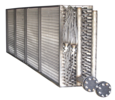Why Heat Exchangers Fail

Heat exchangers can fail for a variety of reasons. Since heat exchangers typically transfer heat from water, steam or gas to other fluids or gases, additives and impurities can lead to corrosion. Depending on the type of material used to make the heat exchanger (copper, steel or stainless steel), chemical additives can corrode and weaken sections of the coil, causing pitting or cracking. Mud, algae or other impurities getting into heat exchangers can also cause corrosion. Corrosion leads to performance issues or damage severe enough to require the immediate replacement of the heat exchanger.
Heat exchangers also need to be replaced because of mechanical failure. Excessive fluid velocity inside the tubes can cause metal erosion, typically at the tube entrances or in U bends. Damaging pressure surges or flow control value problems can cause water hammer, which can lead to a rupture in the heat exchanger. Mechanical failure can also be caused by welding faults, fabrication issues or tubing imperfections.
A combination of problems can also cause heat exchangers to fail, including a mix of mechanical issues and chemically-triggered corrosion. Erosion-corrosion and corrosion-fatigue lead to faster heat exchanger failure than chemical or mechanical problems occurring on their own.
Regardless of the reason you need to replace your heat exchanger, we’re here to help. Contact us at 855-Coil-Now or sales@emergentcoils.com today.
